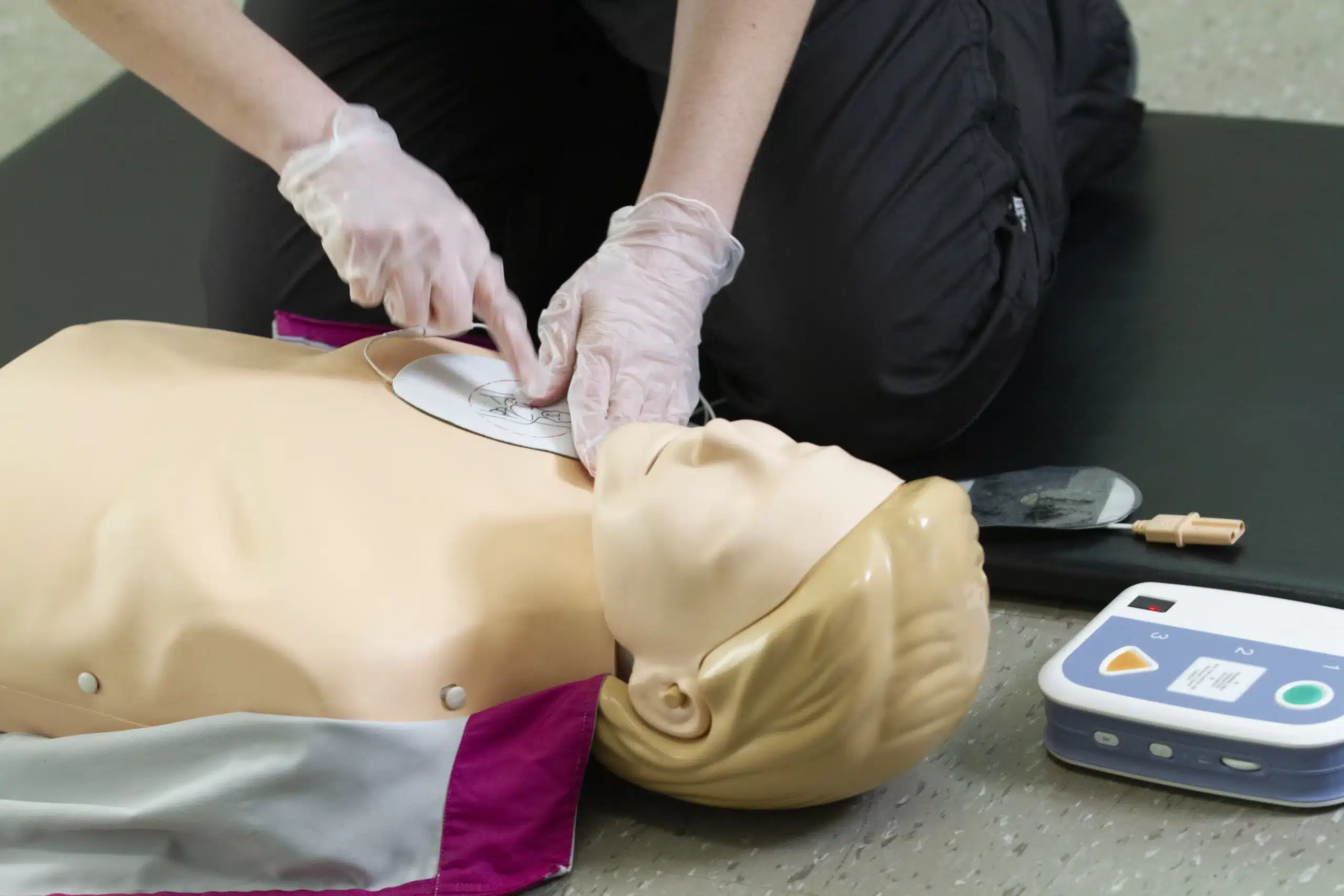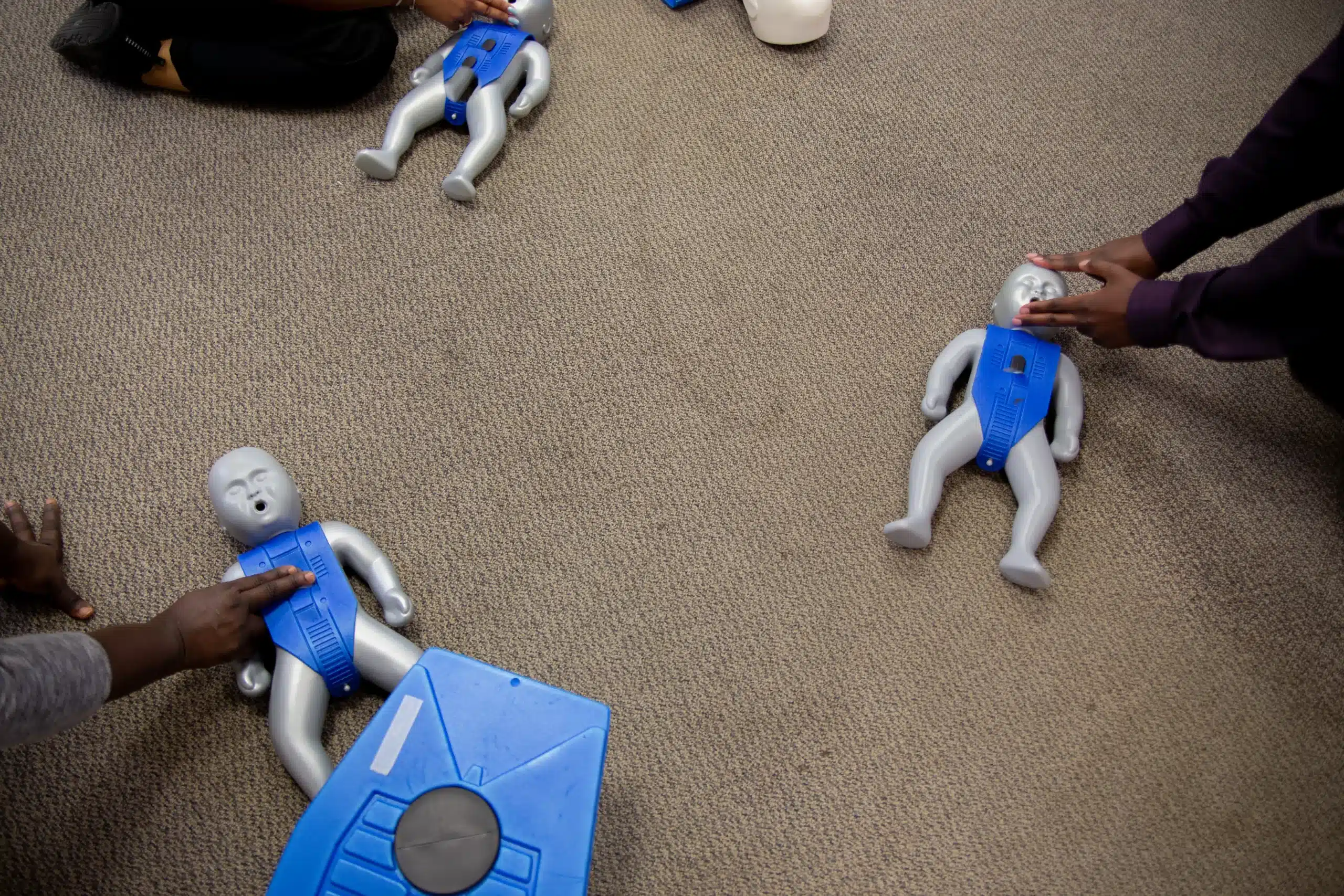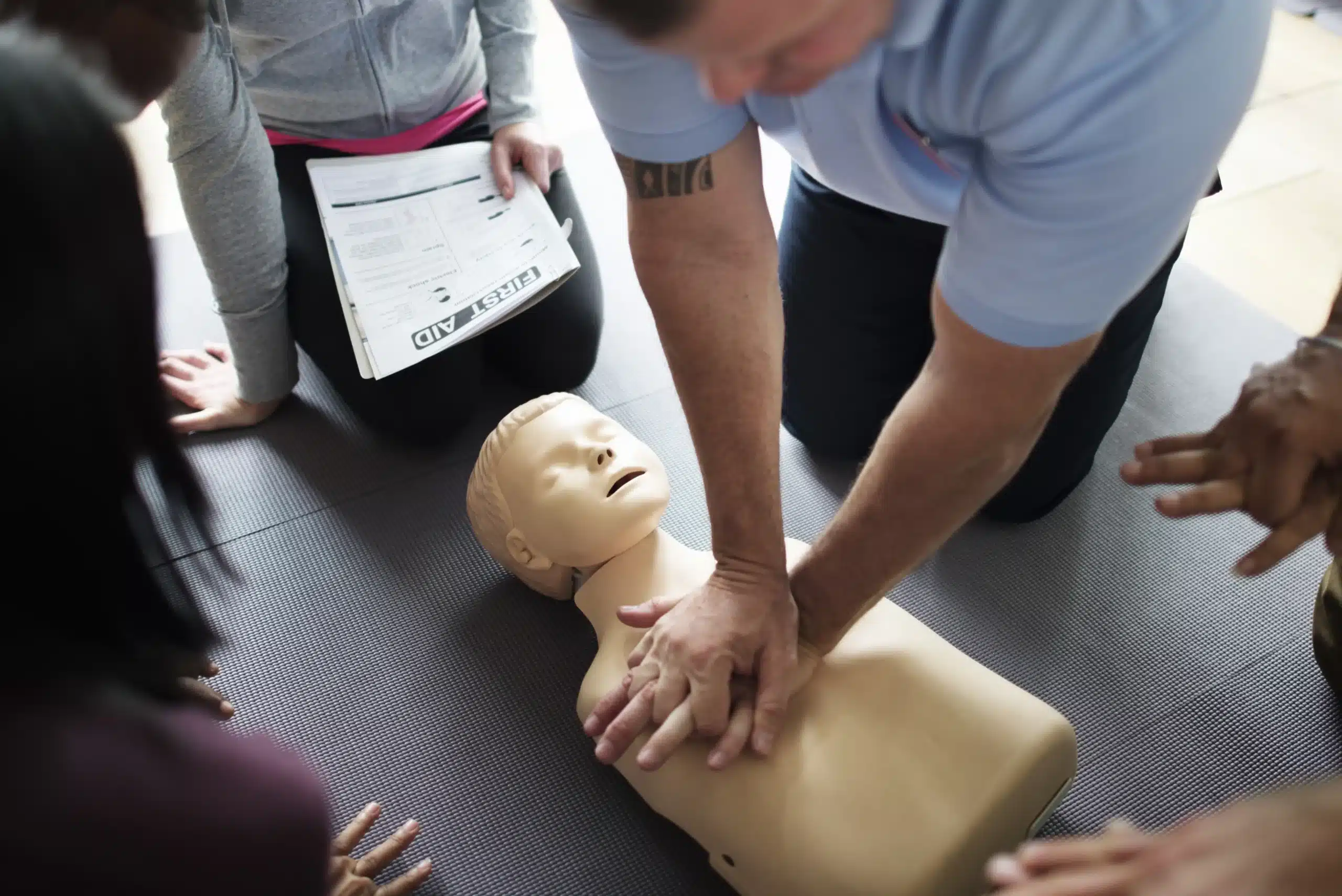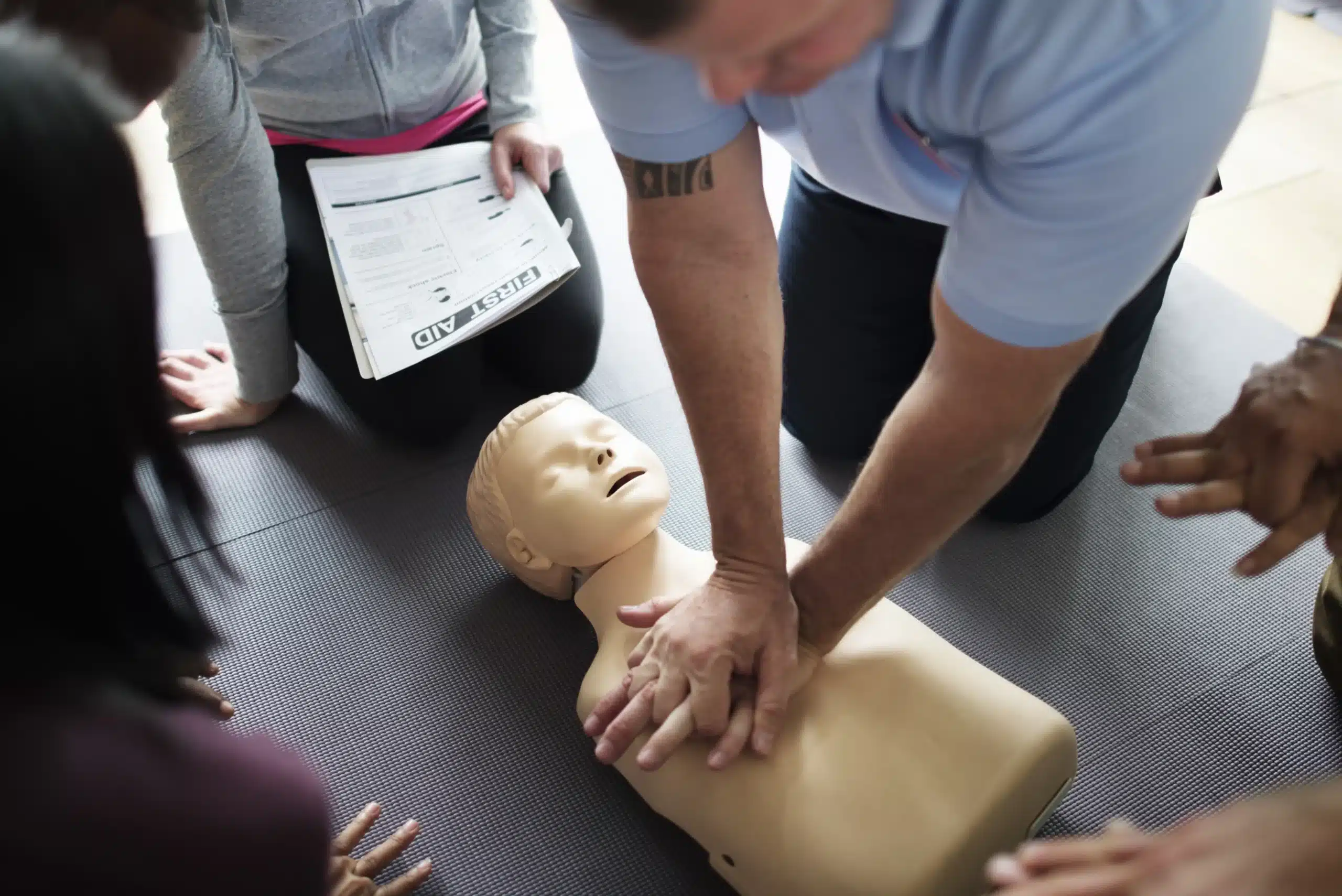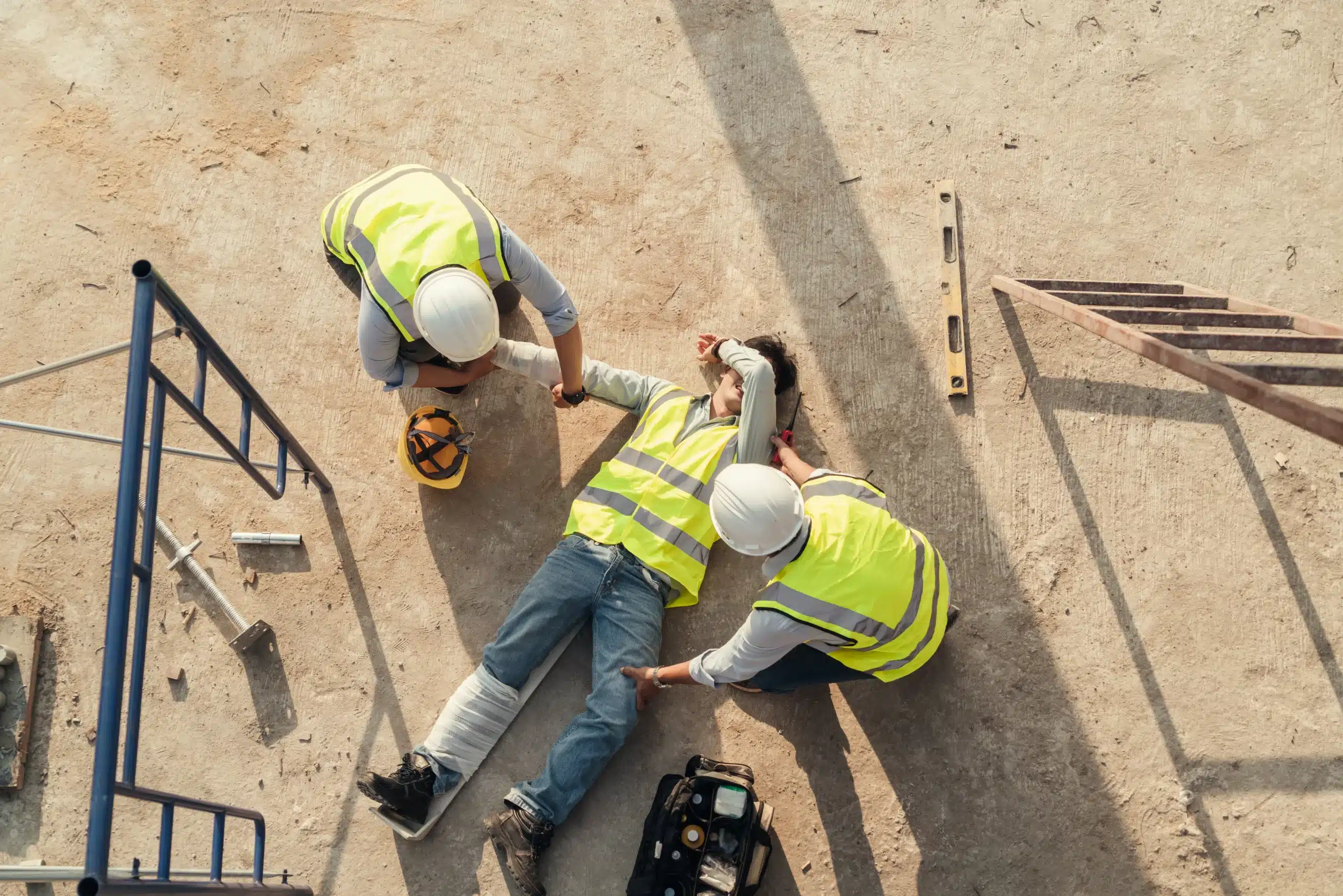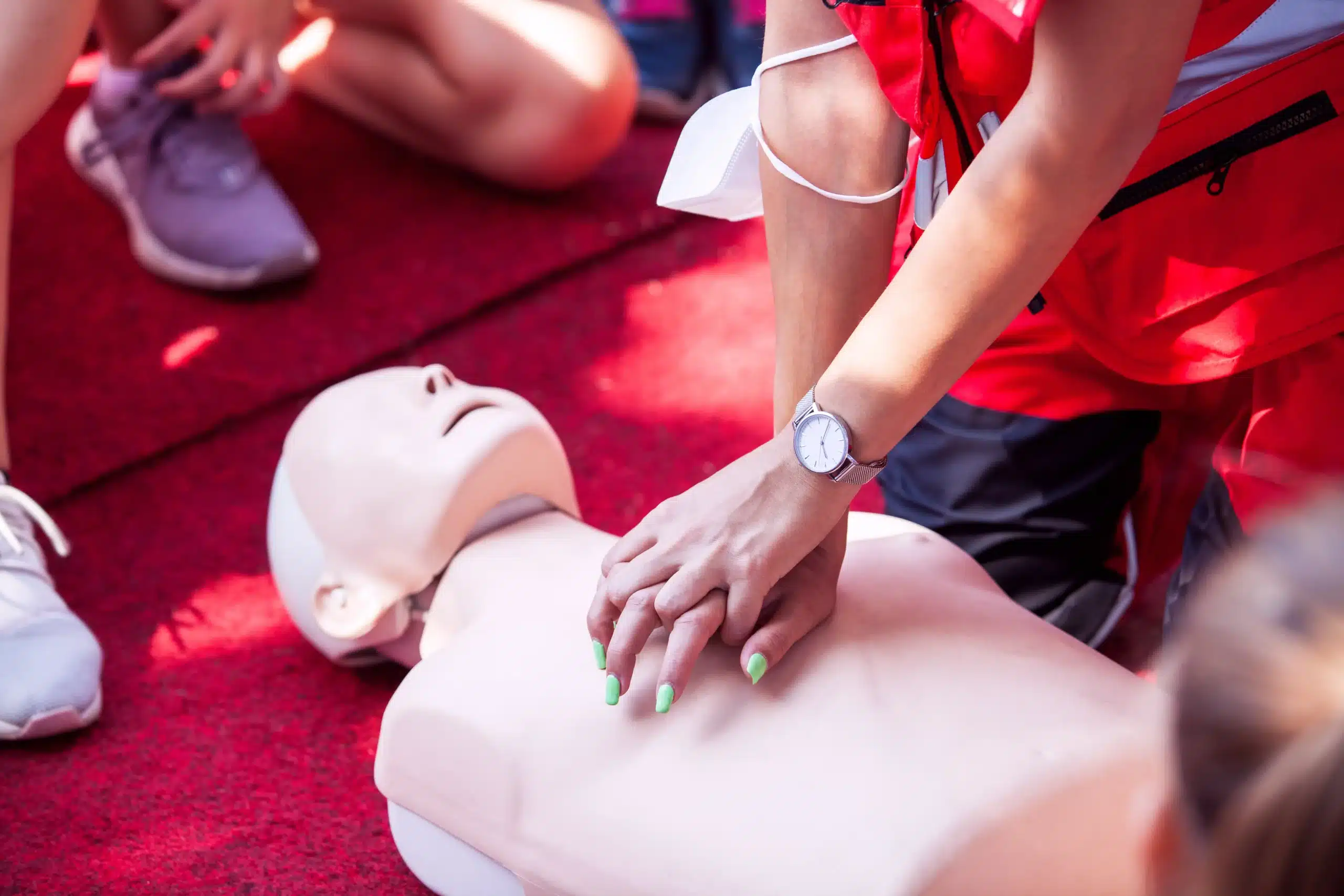Seconds count in a medical emergency, especially when a child is involved. Knowing pediatric CPR and first aid can empower you to act quickly and confidently, providing immediate care until professional help arrives. This guide is your go-to resource for everything related to pediatric CPR and first aid training. We’ll discuss the differences between adult and pediatric CPR, debunk common myths, and guide you through the process of finding “pediatric CPR and first-aid courses near me.” We’ll also cover what to expect in a class, how to choose the right course format, and how to keep your skills sharp after certification.
Key Takeaways
- Be prepared for pediatric emergencies: Learning pediatric CPR and first aid empowers you to confidently respond to emergencies involving children. Find a course that suits your learning style and schedule.
- Choose the right certification: Understand the different types of certifications, their coverage, and validity periods. Look for reputable organizations and qualified instructors.
- Maintain your skills: Regularly practice and take refresher courses to stay up-to-date on the latest guidelines and maintain your confidence in responding to emergencies.
Why Learn Pediatric CPR and First Aid?
Knowing pediatric CPR and first aid can make a real difference in a child’s life. Emergencies happen, and being prepared to respond effectively can significantly improve outcomes. Think of it as equipping yourself with the skills to protect the children in your life, whether they’re your own kids, nieces and nephews, students, or the children you care for at work. The Heartsaver Pediatric First Aid CPR AED course focuses on immediate responses to illnesses and injuries in children and infants, bridging the gap before professional medical help arrives. This training empowers you to act quickly and confidently during those critical first few minutes. At Redwood City CPR Classes, we understand the importance of these skills and offer comprehensive training to prepare you for any situation.
How Pediatric CPR Differs from Adult CPR
While general CPR training is helpful, it doesn’t replace specialized pediatric training like Pediatric Advanced Life Support (PALS) certification. Children’s bodies are different from adults’, and their responses to emergencies vary as well. Pediatric CPR techniques are tailored to these physiological differences, ensuring you provide the most effective care. PALS certification delves deeper into pediatric emergencies, covering a broader range of scenarios and advanced life-saving procedures. Choosing the right training, like the courses offered at Redwood City CPR Classes, ensures you have the specific skills needed for pediatric emergencies.
Debunking Pediatric CPR Myths
One of the biggest roadblocks to people learning CPR is the fear of doing it wrong. Concerns about causing injury or hesitation about mouth-to-mouth resuscitation are common misconceptions about CPR. It’s important to remember that any attempt at CPR is better than none. These myths, along with general misinformation about first aid and CPR, often prevent people from seeking potentially life-saving training. Learning CPR and first aid from qualified instructors, like those at Redwood City CPR Classes, ensures you’ll learn the correct techniques and gain the confidence to act in an emergency. We’re here to dispel those myths and empower you with the knowledge and skills to make a difference.
What Happens in a Pediatric CPR and First Aid Class?
Knowing what to expect can help you feel confident going into your pediatric CPR and first aid class. Here’s a breakdown of what you’ll cover and how these essential courses work.
What You’ll Learn and How the Class Works
Pediatric first aid and CPR classes equip you with the skills to respond to emergencies involving infants and children. You’ll learn how to recognize and manage a range of situations, from minor injuries like cuts and scrapes to life-threatening emergencies like choking, cardiac arrest, and allergic reactions. The Heartsaver Pediatric First Aid CPR AED course provides the skills needed to manage illnesses and injuries in those crucial first few minutes until professional medical help arrives. The class typically includes lectures, demonstrations, and hands-on practice, led by a certified instructor who will guide you through each skill, answer your questions, and offer personalized feedback. At Redwood City CPR Classes, we emphasize creating a supportive learning environment where you can feel comfortable asking questions and practicing your skills.
How Long Classes Last and Available Formats
The American Heart Association offers a variety of course formats for pediatric first aid, CPR, and AED training, all of which result in the same AHA Course Completion Card. You can choose a traditional classroom setting, or a blended learning experience that combines online coursework with an in-person skills session. The length of the class depends on the format you choose, with blended learning options often providing more flexibility. Redwood City CPR Classes offers various scheduling options to fit your busy life.
Practice Makes Perfect: Hands-on Training
Hands-on practice is a critical component of any pediatric CPR and first aid class. You’ll work with realistic training mannequins to develop the muscle memory and confidence needed to perform CPR effectively. This hands-on training helps you understand the correct hand placement, depth of compressions, and techniques for giving rescue breaths. You’ll also practice using an AED in a simulated emergency. This practical experience is essential for preparing you to respond calmly and efficiently in a real-life crisis.
Find the Best Pediatric CPR and First Aid Classes Near You
Knowing where to look for quality training is the first step. This section breaks down common providers and resources to help you on your way.
Where to Find Training
American Red Cross
The American Red Cross offers a variety of CPR and first-aid courses, including blended learning options that combine online instruction with in-person skills sessions. Their Adult and Pediatric First Aid/CPR/AED course covers essential life-saving techniques for adults, children, and infants. Check their website for class schedules and locations near you.
American Heart Association
The American Heart Association (AHA) provides comprehensive training programs, such as the Heartsaver Pediatric First Aid CPR AED course. This course is designed for individuals involved in childcare and equips them with the skills to respond to emergencies involving children and infants. The AHA website offers resources to locate certified training centers in your area. Redwood City CPR Classes offers several American Heart Association courses, including BLS, ACLS, and PALS.
National Safety Council
The National Safety Council also offers a range of CPR and first aid training options, including pediatric-focused courses. They often provide training through local chapters or partner organizations, making it convenient to find a class near you. Explore their website to learn more about their programs and locate training opportunities.
Local Hospitals and Community Centers
Many local hospitals and community centers offer CPR and first aid classes, often at reduced costs or even free. These can be excellent resources, especially for parents and caregivers. Check with your local hospital or community center for upcoming class schedules. You can also search online for “CPR classes near me” to find local training options.
Online or In-Person: Which Class Format is Right for You?
Deciding between online and in-person classes depends on your learning style and schedule. Online courses offer flexibility, allowing you to learn at your own pace. In-person classes provide hands-on practice and direct interaction with an instructor. CPR1 offers a helpful explanation of different class types and associated costs. Redwood City CPR Classes offers both in-person and blended learning courses to suit different learning preferences. We also offer group discounts for those training together.
Use Online Course Locators
Several websites offer online course locators to help you find CPR and first aid classes in your area. These tools allow you to compare courses based on cost, format, and availability. Health Education Pro is one such resource that can simplify your search. Redwood City CPR Classes also has a low price guarantee, ensuring you receive high-quality training at a competitive price.
How Much Do Pediatric CPR and First Aid Classes Cost?
Knowing the price range for Pediatric CPR and First Aid classes helps you budget and compare options. Several factors influence the final cost, so understanding these will help you find the best value.
Typical Prices
Combined CPR and First Aid certification classes usually cost between $75 and $200, which often covers the certification fees. You might find Pediatric CPR classes on their own for around $25–$40. Basic CPR certification typically falls in the $50–$150 range, while more advanced certifications, or those including comprehensive first aid, can cost $200 or more. Remember, these are just averages, and prices can vary. Redwood City CPR Classes offers a low price guarantee so you always know you’re getting a competitive rate. For specific pricing, it’s always best to check with your chosen provider.
What Affects Course Costs?
Several things can influence class pricing. The length of the course matters—longer courses tend to be more expensive. The type of certification also plays a role. For example, basic CPR certification is typically less expensive than advanced certifications like ACLS or PALS. The location of the class can also affect pricing. Courses at hospitals or specialized training centers might have different costs than those offered at community centers. Finally, any extra materials or certifications included in the course can impact the total cost.
Discounts and Promotions
Before you sign up, ask about potential discounts. Many providers offer discounts for groups, students, or early registration. Some also run seasonal promotions or have loyalty programs. Check if your employer offers any reimbursement for these types of courses, too. Redwood City CPR Classes offers group discounts, so if you’re training with friends or colleagues, be sure to ask. A little research can often save you money.
What Certifications Will You Earn and Why Do They Matter?
Earning a CPR and first-aid certification is a rewarding accomplishment. It means you’re prepared to help in a medical emergency. But not all certifications are the same. Understanding the different types, what they cover, and how long they’re valid helps you choose the right course. This knowledge also ensures your certification stays current, so you’re always ready to assist.
Types of Certifications
Several recognized organizations offer CPR and first-aid certifications. Two of the most prominent are the American Red Cross and the American Heart Association. The American Red Cross offers certifications like Adult and Pediatric First Aid/CPR/AED, covering various skills for responding to emergencies for both children and adults. The American Heart Association provides certifications such as Heartsaver Pediatric First Aid CPR AED. This course focuses on responding to emergencies involving children and infants, ideal for childcare providers, teachers, and parents. Choose the certification that aligns with your goals. For example, if you work at a summer camp, a pediatric-focused certification would be beneficial. Redwood City CPR Classes offers a range of courses to meet your specific needs. You can explore our American Heart Association BLS, ACLS, and PALS certifications on our website.
How Long Certifications Last and How to Renew Them
Most CPR and first-aid certifications are valid for two years. This timeframe reflects the evolving nature of best practices in emergency care. Staying up-to-date with the latest guidelines ensures you provide effective care. To maintain your certification, take a renewal course before it expires. Renewal courses cover any updates to the guidelines and refresh your skills. Many organizations offer convenient renewal options, including online and in-person formats. Check with your certifying organization, like the American Heart Association, for their specific renewal process and available courses. Don’t let your certification lapse—stay prepared and confident in your abilities. For convenient and affordable renewal options in the Redwood City area, check out our low price guarantee and group discounts.
Choose the Right Pediatric CPR Class
Choosing the right pediatric CPR class is a personal decision. Think about what will set you up for success—from how you learn best to what fits your busy schedule. Taking a few minutes to consider these factors now will make a big difference in how confident you feel going into (and coming out of) your training.
What’s Your Learning Style?
Are you a hands-on learner, someone who thrives in a traditional classroom, or do you prefer the flexibility of online modules? Luckily, there are options for everyone. The American Heart Association, for example, offers blended learning courses that combine online instruction with in-person skills practice. This approach lets you learn the basics at your own pace before demonstrating your skills to an instructor. If you prefer a fully in-person experience, many organizations offer traditional classroom-based Heartsaver Pediatric First Aid CPR AED training. Redwood City CPR Classes offers a variety of formats to suit different learning styles, so you can find the perfect fit.
Consider Your Schedule
Between work, family, and other commitments, finding time for a CPR class can be tricky. That’s why it’s important to consider your schedule when selecting a class. Look for courses offered on weekends, evenings, or even during weekdays if your schedule allows. Some providers, like Redwood City CPR Classes, offer flexible scheduling options and group discounts to accommodate busy lifestyles. Also, think about the total time commitment. While some courses can be completed in a single day, others might be spread out over several sessions. Knowing the duration and schedule upfront will help you avoid any surprises and ensure the class fits seamlessly into your calendar. Don’t let a busy schedule stop you from learning this life-saving skill. With a little planning, you can find a pediatric CPR class that works for you. Check out our low price guarantee to find a course that fits your budget, too.
Get Ready for Your Pediatric CPR and First Aid Class
So, you’ve signed up for a Pediatric CPR and First Aid class—that’s great! This means you’re ready to learn how to handle emergencies involving children and infants. To make the most of your upcoming training, here are a few things you can do to prepare.
What to Bring
For most CPR and first-aid courses, you won’t need much. Comfortable clothing is essential, as you’ll be actively practicing skills like CPR compressions. A notebook and pen might be helpful for taking notes, though many courses provide printed materials. If you wear glasses or contacts, be sure to bring them so you can clearly see demonstrations and participate fully in hands-on practice. Other than that, just bring a positive attitude and a willingness to learn!
The Heartsaver Pediatric First Aid CPR AED course from the American Heart Association focuses on responding to and managing illnesses and injuries in children and infants until professional help arrives. While the course is designed for adults, the Red Cross recommends their Babysitter’s Training and Pediatric First Aid/CPR course for those aged 11-15.
Study Materials
While pre-studying isn’t typically required, familiarizing yourself with the basics can increase your confidence. The American Heart Association offers various resources on their website, including information on pediatric CPR, AED use, and first aid. You can also find helpful videos and articles online demonstrating proper techniques. Remember, all Heartsaver courses teach the same science-backed skills and result in the same AHA Course Completion Card. Your primary focus should be absorbing the information presented during class and actively participating in the hands-on practice. This will best prepare you to respond effectively in a real-life emergency.
Keep Your Skills Sharp After Certification
Once you’re certified in pediatric CPR and first aid, regular practice is key to staying prepared for emergencies. Like any skill, CPR and first aid techniques can fade if you don’t use them. Here’s how to keep your skills sharp:
Refresher Courses
Even if your certification is still valid, consider taking a refresher course periodically. These courses reinforce your skills and introduce any updated guidelines. Plus, practicing in a classroom setting with an instructor and other students can boost your confidence. Refresher courses are often shorter and more affordable than initial certification courses, making them a cost-effective way to stay up-to-date. Redwood City CPR Classes offers a variety of refresher courses, including BLS, ACLS, and PALS. Check with your certifying organization, such as the American Heart Association, for recommendations on how often to refresh your training.
Practice at Home
Regular practice at home is essential for maintaining muscle memory and confidence in your CPR and first-aid skills. While you won’t have the same equipment as a classroom, you can still practice key techniques. Review the steps for performing CPR on infants and children, focusing on chest compression depth and rate. You can practice compressions on a pillow or stuffed animal to get a feel for the correct pressure. Visualize different first-aid scenarios, such as treating minor cuts and burns, and mentally walk through the appropriate steps. Even simple visualization can help you react more effectively in a real emergency. Consider investing in a CPR training mannequin for more realistic compression practice. Online resources can also help you review techniques and stay current on best practices.
Train as a Group
Want to train your entire team or organization in pediatric CPR and first aid? Group training offers a streamlined and cost-effective approach.
Benefits of Group Training
Group training creates a collaborative learning environment where participants can practice together, boosting their confidence and retention. It’s a smart choice for organizations like schools, daycare centers, and community groups. CPR Select points out that group training can be customized for large groups, making it an efficient option for any organization. Everyone learns the same techniques and can support each other during emergencies. Plus, training together builds camaraderie and teamwork, strengthening communication skills crucial in high-pressure situations.
Group Discounts
Training as a group often comes with cost savings. Many providers, including CPR Select, offer discounts for group registrations, lowering the per-person cost. Redwood City CPR Classes also offers group discounts, making it more affordable to equip your whole team with these life-saving skills. Beyond the financial benefits, group discounts allow organizations to invest in high-quality, tailored training that addresses their specific needs. This proactive approach creates a culture of safety and preparedness.
How to Choose a Great Pediatric CPR and First Aid Class
Picking the right Pediatric CPR and First Aid class is a big decision. You want training that will truly prepare you for an emergency. Here’s what to look for:
Evaluate Course Quality
First, look for a comprehensive program. It should cover both CPR and first aid techniques specifically designed for infants and children. The American Heart Association’s Heartsaver Pediatric First Aid CPR AED course teaches how to respond to and manage illnesses and injuries in those critical first few minutes before professional help arrives. Make sure the course content aligns with current guidelines and best practices. A good program will also offer hands-on practice and realistic scenarios.
Read Reviews and Testimonials
Reading reviews and testimonials from past participants can give you valuable insights. Look for comments about the instructor’s teaching style, the quality of the materials, and the overall learning environment. Consider factors like course duration, the institution’s reputation, the certification level, and any bundled offerings to find a class that fits your budget and learning objectives. CPR1 offers a helpful guide on CPR class costs and what to expect.
Check Instructor Credentials
The instructor’s qualifications are just as important as the course material. Confirm that instructors are certified and have a solid background in teaching Pediatric CPR and First Aid. The American Heart Association’s Heartsaver Pediatric First Aid CPR AED Course is designed for anyone involved in childcare who might need to respond to a child or infant’s illness or injury, so look for instructors with experience in this area. A knowledgeable and engaging instructor can make all the difference in how much you learn and retain.
Related Articles
- Pediatric CPR & First Aid Training in Menlo Park – Redwood City CPR Classes
- Pediatric Advanced Life Support (PALS) in Palo Alto – Redwood City CPR Classes
- Debunking Common CPR Myths for Potential Lifesavers
- Pediatric CPR & First-Aid Classes in Palo Alto – Redwood City CPR Classes
- Find CPR Certification Near Me: A Practical Guide – Redwood City CPR Classes
Frequently Asked Questions
Is pediatric CPR drastically different from adult CPR? Yes, there are key differences between pediatric and adult CPR, mainly due to the differences in children’s physiology and responses to emergencies. Pediatric CPR techniques are specifically tailored to these differences, ensuring the most effective care for infants and children. While general CPR knowledge is helpful, it’s not a substitute for specialized pediatric training.
What if I’m too afraid I’ll do something wrong during an emergency? It’s normal to feel apprehensive about performing CPR, but remember any attempt at CPR is better than none. Hesitation due to fear of incorrect technique can be detrimental. Proper training will equip you with the correct skills and boost your confidence, allowing you to act quickly and effectively in a real emergency.
What’s the typical cost of these courses, and are there ways to save money? Costs vary based on factors like course length, certification type, location, and included materials. However, many providers offer discounts for groups, students, or early registration. It’s always a good idea to inquire about potential cost savings before registering.
How can I fit a CPR class into my already busy schedule? Many training centers understand busy schedules and offer classes on evenings, weekends, or in blended formats (online coursework combined with in-person skills sessions). Blended learning offers flexibility, allowing you to complete the online portion at your own pace before attending a shorter in-person skills session.
How can I make sure I retain the information after completing the course? Regular practice is key to retaining CPR and first-aid skills. Consider taking refresher courses periodically and practicing key techniques at home. Even visualizing scenarios can help maintain your preparedness for real-life emergencies. Many online resources also offer refreshers on techniques and updated best practices.
